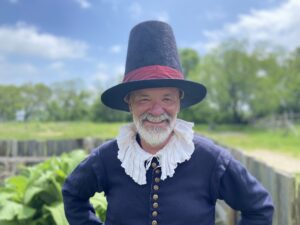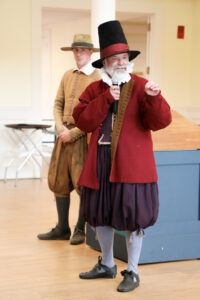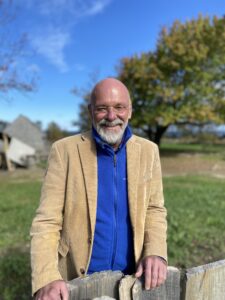By Colin McCandless, Contributing Writer

Photo/Courtesy of Plimoth Patuxet Museum
PLYMOUTH – Perhaps researching and depicting colonial history is just in Richard Pickering’s DNA. He grew up in Braintree, the birthplace of John Adams, John Quincy Adams and John Hancock. The First Congregational Church he attended was the site where John Adams spoke out against the legality of the Stamp Act and debated its constitutionality.
Long tenure
Pickering is the deputy executive director and senior historian at Plimoth Patuxet Museums, the living history museum of 17th-century Plymouth Colony and the Wampanoag Homeland. He has spent nearly 40 years with the institution, serving in various capacities such as historical role player, research associate, director of education and director of special projects.
After graduating from college and working in retail, Pickering landed his first job with the museum in 1984 as a historical role player. “A friend told me I had the personality for it, and I had no idea what he meant,” Pickering recalled. “I came on a job interview not knowing what the job actually entailed in the slightest.” He initially played the part of Philip Delano, who arrived in Plymouth Colony in 1621 and is Franklin Delano Roosevelt’s grandfather to the ninth generation or so back, added Pickering.
He has since played around 12 different people over the years. Performers at Plimoth Patuxet change roles as they get older so that historical figures are age appropriate. Pickering, 63, currently plays elder William Brewster, the ruling elder of the congregation. The part suits Pickering not only because of his age, but the fact that his father originally had plans of becoming a minister and he was raised in the Congregational Church.
“It just gave me the essential background that was needed to represent the highest officer of the church,” related Pickering. “For a historian, it is the ultimate experience because you keep returning to the same story,” he explained. “But when you have to enter that story from the perspective of someone else, whether it’s regional difference in England, religious difference, level of education—it’s really forcing you to look at this diamond from every facet. And you begin to understand the complexity of the community when you’re trying to recreate individual lives within that community.”
A guest-centered approach

Photo/Courtesy of Plimoth Patuxet Museum
Besides his deputy executive director leadership duties overseeing the museum’s programs, as senior historian, Pickering is very hands on with ongoing research and the development of public programs based on that research. He described himself as a public historian, “which means that all the work that you do is intended to reach general audiences,” he explained. “But it’s based and grounded in the richest academic and archaeological resources.”
Pickering strives to make history more accessible and palatable to the public. “In some ways I’m a mediator between informal learners and the academy,” he explained. “And in this position, I’m moving back and forth between what the average American wants to learn or would be interested in,” he noted. “And also helping academic historians begin to approach their work in ways that aren’t limited to just reaching other academics, but having a broader audience for a greater impact.”
He said, for example, that Plymouth creates this experiment in self-government and establishes four important law codes of the 17th century, one of which is recognized by scholars as the first Bill of Rights in the English-speaking world. “And so that’s an important story that we’re trying to tell and have more people be aware of.”
One of the most significant changes Pickering’s seen during his time with the museum is the shift to a more guest-centered approach that ensures the experience is more meaningful. “And that they’re walking away from us with pragmatic applications for living.”
Evolution of the museum
The museum’s name has also evolved. Founded in 1947 as Plymouth Plantation, to mark the 400th anniversary of the Mayflower voyage, they initiated discussions with the surrounding native communities about approving a name change to honor the Indigenous Wampanoag.
“For Wampanoag people, this is Patuxet. The place of little waterfalls. And it’s also Plymouth,” noted Pickering. “And so, by changing our name, we’re also helping our guests understand they’re on a landscape that’s been occupied for 12,000 years. And that it is still Patuxet for Native People, even though it possesses the English name it was given by Prince Charles.”
Pickering said the museum has also come to acknowledge the reality that most people will not have the opportunity to physically visit the museum, which necessitates building a strong digital presence.
To meet that demand, they installed a live stream digital studio at the museum using $2.5 million in funding from the Lilly Endowment in Indianapolis. They also funded the production of a series of short documentaries on the history of religion in Plymouth Colony as well as two TED-style talks that will eventually be available online.
Pickering’s favorite part of working at Plimoth Patuxet as deputy executive director in recent years has been endeavoring to make the museum a kinder, gentler place. “That you felt welcome the moment you came in. The staff has engaged that project so beautifully,” he enthused. “We just try to be that little, little place here in Plymouth, that’s trying to teach big lessons in every encounter that we have.”
An immersive experience
Plimoth Patuxet comprises several major exhibits: the Historic Patuxet Homesite that examines the life of the Wampanoag, the 17th-century English Village, Mayflower II, the craft center and visitor center and Plimoth Grist Mill.

Photo/Courtesy of Plimoth Patuxet Museum
The Patuxet Homesite representing Wamponoag history is located on the site of a Wampanoag summer village. When French explorer Samuel de Champlain explored New England and charted the area in 1605, Patuxet was included on that map.
In the English Village, to the role players the year is 1627. But if you’re talking with a modern tour guide, they can examine the colony’s entire 70-year history. “We’re giving guests multiple ways of engaging the past,” remarked Pickering.
On the waterfront is Mayflower II, a full-scale reproduction of the Mayflower that transported the Pilgrims to the New World in 1620. It was brought over to the museum from England in 1957. An estimated 27 to 30 million people have toured the historic ship replica since then, said Pickering. “And really that is the most recognizable of our sites because of the fame of the ship.”
Plimoth Grist Mill is a reproduction of a mill built in the 1630s. The reproduction was constructed in the 1970s and it still grinds corn meal.
The museum continues to evolve under Pickering’s leadership and find novel ways of drawing new visitors. In December 2023, Plimoth Patuxet held an inaugural Winter Fine Arts & Craft Fair featuring 70 artisans from around the country that attracted 2,000 regional visitors. “The response was huge,” asserted Pickering. So big, in fact, that they have made the craft fair an annual event.
They have offered their popular Thanksgiving dinner programs for 40 years, called the “Story of Thanksgiving.” Pickering hosts three seatings the day of and two the day after due to the high demand.
Additionally, the museum operates a cinema out of its visitor center that screens arthouse and independent films nightly.
“We’re trying to be that place where you come to Plimoth Patuxet, but you don’t necessarily need to care about history,” said Pickering.
For information on hours and tickets, visit plimoth.org.
RELATED CONTENT:
Salem museum’s head gardener ‘digs’ her job (fiftyplusadvocate.com)
Hudson museum offers a unique, immersive historical experience (fiftyplusadvocate.com)
Unusual museums make for some offbeat outings (fiftyplusadvocate.com)












